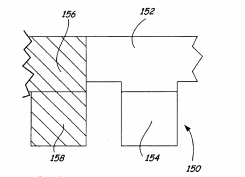Etching is a class of common processes for the controlled removal of material. Etching of alumina is found in various applications including the fabrication of microde vices, Specifically thin film magnetic structures and more Specifically magnetic heads. There are various types of etching processes; however they all generally include the common actions of transport of reactants to the Surface, Surface reaction, and transport of products from the Surface.
of etching processes. The etch rate is the decrease in etch material thickness verSuS time. Faster etch rates are usually favored, but must be balanced with the ability to control the total amount of material removed. Uniformity of etching acroSS a Surface and between Surfaces is desired. Isotropy of the etching process is also considered. The characteristics of Selectivity and damage caused by the etch process often control which type of etch process is used for a particular application. Selectivity and damage will be further discussed below.
Frequently the Surface is composed of more than one type of material, only one of which is desired to be etched. The material to be etched is referred to as etch material. Underlayers and Surrounding material refer to the rest of the structure that is not to be etched. Selectivity is generally defined as a ratio of the etch rate of the etch material to the etch rate of the other portions of the structure that are not to be etched. Damage is often directly related to selectivity. If perfect selectivity could be achieved, only the etch material would be removed and no etching would occur to other materials. If Selectivity is poor, then etching to the other materials is likely extensive, therefore described as damage. Damage may also occur by incompatibility, usually chemical in nature, between components of the etching proceSS and materials in the Structure resulting, for example, in corrosion of the Structure.
Wet etching, as compared to dry etching, is gen erally simpler, cheaper and faster. The general proceSS is to drop the items to be etched into a container holding the wet etchant. The main ingredients of conventional wet etchants are: an oxidizer, for example hydrogen peroxide or nitric acid; an acid or base to dissolve the oxidized Surface, for example Sulfuric acid or ammonium hydroxide; and a dilu ent media to transport reactants and products, for example water or acetic acid. When etching is complete, the items are removed and cleaned. Wet etching can be performed as a batch process, So is fast for processing larger numbers of items and reproducible. Control of wet etching is achieved by adjusting the etching time (e.g. the time in the bath) and the etching rate, which is related to the temperature and composition of the bath. Wet etching is preferred over dry etching for reasons of efficiency, but is limited in its appli cation by poor Selectivity and damage with Some materials.
There are several disadvantages to conventional wet etching for the etching of alumina. The main problem is that alumina is typically to be etched on Structures that also contain transition metals. Conventional wet etchants for alumina, Such as: EDTA (ethylenedinitrilo)tetraacetic acid, concentrated acids, and concentrated bases, all have poor Selectivity between alumina and transition metals. Poor Selectivity results in damage and corrosion to the metal portions of the structure. Metal underlayers beneath the alumina etch material are exposed and often Suffer damage affecting later connections to be made at those metal under layers. Additionally, the resist materials that are applied to the Structure to control where etching occurs often fail in acid etching environments detrimentally affecting the Struc tures. In addition, purity is a critical concern in all electronic materials processing. Highly corrosive materials, Such as acids and other very reactive materials are difficult to purify.
The novel wet etchant demonstrates high selectiv ity for etching alumina Versus other Sputtered or electro plated transition metals and alloys typically used in the manufacturing process for magnetic heads. Selectivity of the novel wet etchant was measured by comparing the etch rate of alumina to the etch rate of metal layers. A graph showing the decrease in layer thickness over time due to etching by the novel wet etchant is shown in FIG.1. As shown in FIG. 1, the alumina is etched with a substantially uniform rate of approximately 12 nm/min. The Cu, NiFe and Ru. Samples show very little change in thickness with etching times of an hour or more at an approximate loSS less than or equal to 1 nm of material thickness per minute. The selectivity of the novel wet etchant for alumina to copper is greater than 10:1; for alumina to NiFe and alumina to NiV is greater than 16:1; and for alumina to Pt, alumina to Au and alumina to Ru, the selectivity is greater than 1000:1.

Fig1
Dry etching of alumina has proved challenging. Solid alumina or aluminum oxide is thermodynamically Stable in comparison to the products produced through chemical dry etch processes. Consequently, alumina requires dry etching dominated by physical attack, e.g. a lot of ion bombardment, to basically knock the atoms apart and then etch the aluminum Separately. A commonly used tech nique for dry etching alumina is reactive ion etching, which is a type of Sputtering. In reactive ion etching, a Voltage is applied to the plasma and the Substrate Surface. The Voltage difference acts to accelerate particles out of the plasma to Strike the Surface with an increased energy. A combination of chemical and physical etching of the Surface takes place. A variation of reactive ion etching is ion beam etching, where an ion gun provides the ions used to Strike the Surface.
上一篇: 硅薄膜太阳能电池应用中氧化锌的电化学蚀刻
下一篇: 用于MEMS谐振器的氮化铝蚀刻工艺